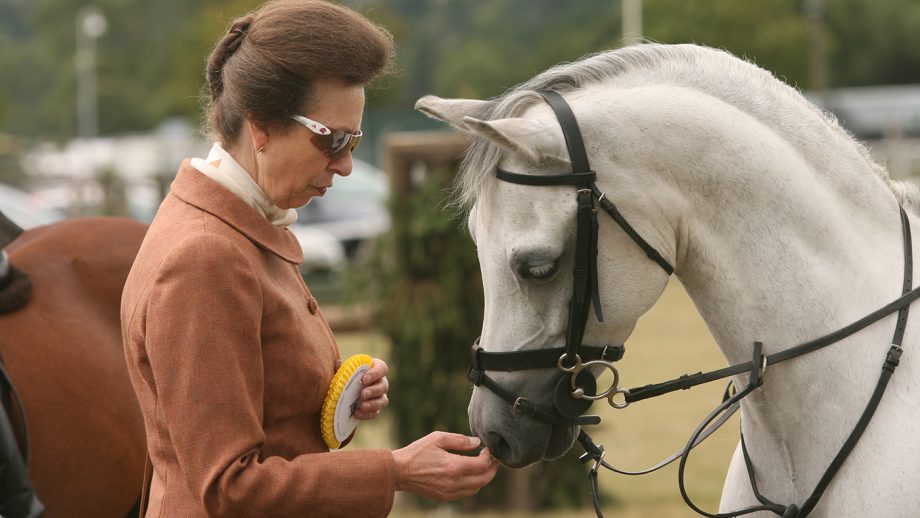As the Princess Royal turns 70 this weekend, Madeleine Silver charts an equestrian career that threw eventing into the spotlight as she became the first member of the royal family to compete at an Olympic Games
“It was a fairy story ending,” read the 1971 Horse & Hound report of Princess Anne’s eventing victory at the European Championships at Burghley. “Of course, everyone knows now that the Princess Royal won the individual championship, but only those who were there can appreciate the extent of the popularity of her victory, or the tension that gripped the thronged arena during her jumping round on Sunday.”
The reporter WW Thomson’s gushing account of the 21-year-old’s performance aboard Doublet perhaps reflected a nation gripped by this sporting tale; a rapid rise to the top, a home-bred destined to be a polo pony and a mother who happened to be The Queen.
“This really was a fabulous event. The Queen and Prince Philip were there, the weather was right, the winners were right, and Princess Anne not only beat the best in Europe, but trounced them,” it read.
{"content":"PHA+SW4gdGhlIGZvbGxvd2luZyBkZWNhZGUsIHRoZSBQcmluY2VzcyB3YXMgb24gdGhlIHBvZGl1bSBhdCBhbm90aGVyIEV1cm9wZWFuIENoYW1waW9uc2hpcHMgd2l0aCBhIGRpZmZlcmVudCBob3JzZSwgYXQgYW4gT2x5bXBpYyBHYW1lcyBhbmQgaW4gdGhlIHRvcCAxMCBvZiB0aGUgd29ybGTigJlzIGJpZ2dlc3QgZm91ci1zdGFycywgc2lsZW5jaW5nIGFueSBzY2VwdGljcyB3aG\/igJlkIHdvbmRlcmVkIGlmIEJ1cmdobGV5IGhhZCBiZWVuIGEgY2hhbmNlIGZlYXQuPC9wPgo8cD7igJxJdCB3YXMgdmVyeSBuZXcgcmVhbGx5LCBoYXZpbmcgYSB3b21hbiByb3lhbCBkb2luZyBzdWNoIGEgdG91Z2ggc3BvcnQs4oCdIHJlZmxlY3RzIGhlciBmZWxsb3cgY29tcGV0aXRvciBhbmQgZm9ybWVyIHRlYW0tbWF0ZSA8YSBocmVmPSIvdGFnL2x1Y2luZGEtZ3JlZW4iPkx1Y2luZGEgR3JlZW48L2E+LiDigJxOb3QgbG9uZyBiZWZvcmUsIGV2ZW50aW5nIHdhcyBjb25zaWRlcmVkIGEgbWFu4oCZcyBzcG9ydC4gU2hlIHdhcyBtb3JlIHRoYW4gdXAgdG8gdGhlIHRhc2sgb2YgZXZlbnRpbmcsIGJ1dCBzaGUganVzdCBoYWQgdG8gZGVhbCB3aXRoIHRoZSBwcmVzcywgd2hpY2ggaXMgbmV2ZXIgZWFzeS4gSW4gcmV0cm9zcGVjdCBzaGUgZGlkIG91ciBzcG9ydCBhIGh1Z2Ugc2VydmljZS7igJ08L3A+CjxwPjxkaXYgY2xhc3M9ImFkLWNvbnRhaW5lciBhZC1jb250YWluZXItLW1vYmlsZSI+PGRpdiBpZD0icG9zdC1pbmxpbmUtMiIgY2xhc3M9ImlwYy1hZHZlcnQiPjwvZGl2PjwvZGl2PjxzZWN0aW9uIGlkPSJlbWJlZF9jb2RlLTMxIiBjbGFzcz0iaGlkZGVuLW1kIGhpZGRlbi1sZyBzLWNvbnRhaW5lciBzdGlja3ktYW5jaG9yIGhpZGUtd2lkZ2V0LXRpdGxlIHdpZGdldF9lbWJlZF9jb2RlIHByZW1pdW1faW5saW5lXzIiPjxzZWN0aW9uIGNsYXNzPSJzLWNvbnRhaW5lciBsaXN0aW5nLS1zaW5nbGUgbGlzdGluZy0tc2luZ2xlLXNoYXJldGhyb3VnaCBpbWFnZS1hc3BlY3QtbGFuZHNjYXBlIGRlZmF1bHQgc2hhcmV0aHJvdWdoLWFkIHNoYXJldGhyb3VnaC1hZC1oaWRkZW4iPg0KICA8ZGl2IGNsYXNzPSJzLWNvbnRhaW5lcl9faW5uZXIiPg0KICAgIDx1bD4NCiAgICAgIDxsaSBpZD0ibmF0aXZlLWNvbnRlbnQtbW9iaWxlIiBjbGFzcz0ibGlzdGluZy1pdGVtIj4NCiAgICAgIDwvbGk+DQogICAgPC91bD4NCiAgPC9kaXY+DQo8L3NlY3Rpb24+PC9zZWN0aW9uPjwvcD4KPHA+Rm9yIHNvbWVvbmUgYmFyZWx5IG91dCBvZiB0ZWVuYWdlLWhvb2Qgd2hlbiBzaGUgcmVhY2hlZCB0aGUgc3BvcnTigJlzIGhpZ2hlc3QgZWNoZWxvbnMsIHRoZSBQcmluY2Vzc+KAmSBzdGFydCBpbiB0aGUgc2FkZGxlIHdhcyByZWZyZXNoaW5nbHkgbG93LWtleSwgd2l0aCBwb25pZXMgdHVybmVkIG91dCBydWdsZXNzIGFuZCByaWRkZW4gc3RyYWlnaHQgZnJvbSBtdWRkeSBmaWVsZHMuPC9wPgo8cD5UaGUgc2V0dGluZyB3YXMsIG9mIGNvdXJzZSwgZ3JhbmRlciB0aGFuIG1vc3Qg4oCTIFdpbmRzb3IsIFNhbmRyaW5naGFtIGFuZCBCYWxtb3JhbCBzZXJ2ZWQgYXMgc3ByYXdsaW5nIHJpZGluZyBzY2hvb2xzLCBhbmQgZWFybHkgZXF1ZXN0cmlhbiB0aHJpbGxzIGNhbWUgZnJvbSByaWRpbmcgaW4gaGVyIGdyYW5kbW90aGVy4oCZcyBjYXJyaWFnZSB0byB3YXRjaCBUcm9vcGluZyB0aGUgQ29sb3VyIG9uIEhvcnNlIEd1YXJkcyBQYXJhZGUuIEJ1dCB0aGVyZSB3YXMgYWxzbyBhbiB1bnJlbWFya2FibGUgU2hldGxhbmQgKEZ1bSksIGEgaGVmdHkgV2Vsc2ggcG9ueSB3aG8gc3Rvb2Qgb24gaGVyIHRvZSAoS2lyYnkgQ2FuZSBHcmVlbnNsZWV2ZXMpIGFuZCBodW1pbGlhdGluZyBiZW5kaW5nIHJhY2VzIG9uIHRoZSAxMy4yaGggQmFuZGl0LjwvcD4KPHA+QnkgdGhlIHRpbWUgc2hlIHdhcyByaWRpbmcgdGhlIDE0LjJoaCBXYXRlcnNtZWV0IEhpZ2ggSmlua3MsIHdobyB3YXMgc3RhYmxlZCBhdCB0aGUgTW9hdCBIb3VzZSByaWRpbmcgc2Nob29sIGluIEtlbnQgZHVyaW5nIGhlciBsYXN0IHllYXIgb2YgYm9hcmRpbmcgc2Nob29sLCB0aGVyZSB3YXMgbm8gZXNjYXBpbmcgaGVyIGdpbGRlZCBzdGF0dXMuPC9wPgo8ZGl2IGNsYXNzPSJhZC1jb250YWluZXIgYWQtY29udGFpbmVyLS1tb2JpbGUiPjxkaXYgaWQ9InBvc3QtaW5saW5lLTMiIGNsYXNzPSJpcGMtYWR2ZXJ0Ij48L2Rpdj48L2Rpdj4KPHA+T24gb25lIG9jY2FzaW9uLCB3b3JrbWVuIHNwb3R0ZWQgdGhlIFByaW5jZXNz4oCZcyBwb2xpY2VtYW4gbGVhbmluZyBhZ2FpbnN0IHRoZSBlbmQgb2YgdGhlIHNjaG9vbCwgYmVmb3JlIGNhbGxpbmcgb3V0IOKAnOKAmE9pISBZb3UhJiM4MjMwOyBBcmUgeW91IHJveWFsdHkgb3Igc29tZXRoaW5nPyBXaHnigJlzIHRoYXQgbWFuIHdhdGNoaW5nIHlvdT\/igJ0gc2hlIHJlY2FsbHMgaW4gaGVyIDE5OTEgYXV0b2Jpb2dyYXBoeSA8ZW0+UmlkaW5nIFRocm91Z2ggTXkgTGlmZTwvZW0+LjwvcD4KPHA+4oCcQXQgdGhlIGFnZSBvZiAxNiBvciAxNyB5b3XigJlyZSBub3QgdGVycmlibHkgcmVhZHkgd2l0aCBhbiBpbnN0YW50IHJlcGFydGVlIHRvIHF1ZXJpZXMgbGlrZSB0aGF0LCBzbyBJIHJlcGxpZWQsIOKAmFdlbGwsIHllcywgSSBhbS7igJnigJ08L3A+CjxkaXYgY2xhc3M9ImFkLWNvbnRhaW5lciBhZC1jb250YWluZXItLW1vYmlsZSI+PGRpdiBpZD0icG9zdC1pbmxpbmUtNCIgY2xhc3M9ImlwYy1hZHZlcnQiPjwvZGl2PjwvZGl2Pgo8cD5Db21wZXRpdGlvbiBkaXNjaXBsaW5lIGFuZCBtYW5uZXJzIHdlcmUgaW5zdGlsbGVkIGJ5IHRoZSByaWRpbmcgc2Nob29s4oCZcyBvd25lciBDaGVycnkgSGF0dG9uLUhhbGwsIG9uZSBvZiBtYW55IHdobyBoZWxwZWQgc2hhcGUgdGhlIFByaW5jZXNz4oCZcyBldmVudHVhbCBwcm93ZXNzLiBCZWZvcmUgdGhlIFByaW5jZXNzIGFuZCBoZXIgb2xkZXIgYnJvdGhlciB3ZXJlIGNvbXBldGVudCBlbm91Z2ggdG8gcmlkZSB3aXRoIFRoZSBRdWVlbiwgSGVyIE1hamVzdHkgd291bGQgaW1wYXJ0IGtub3dsZWRnZSBmcm9tIGhlciBiaWN5Y2xlIGFzIHNoZSByb2RlIGFsb25nc2lkZSB0aGVtLiBBbmQgdGhlbiB0aGVyZSB3YXMgdGhlIGdyb29tIEZyYW5rIEhhdGNoZXIgYXQgV2luZHNvciwgd2hvIHdhcyBhIHN0aWNrbGVyIGZvciBlbnN1cmluZyBmZWV0IHdlcmUgcGlja2VkIG91dCBhbmQgdGFjayB3YXMgb24gY29ycmVjdGx5LjwvcD4KPHA+QnV0IGl0IHdhcyBwZXJoYXBzIEFsaXNvbiBPbGl2ZXIgd2hvIHdhcyB0aGUgdml0YWwgcGllY2UgaW4gdGhlIHB1enpsZSB0aGF0IGVuYWJsZWQgUHJpbmNlc3MgQW5uZSB0byB0cmFuc2l0aW9uIGZyb20gYSBob3JzZS1tYWQgc2Nob29sZ2lybCB0byBhIHNwb3J0c3dvbWFuIHJpZGluZyBmb3IgQnJpdGFpbiBpbiBqdXN0IHRocmVlIHllYXJzLjwvcD4KPGRpdiBjbGFzcz0iYWQtY29udGFpbmVyIGFkLWNvbnRhaW5lci0tbW9iaWxlIj48ZGl2IGlkPSJwb3N0LWlubGluZS01IiBjbGFzcz0iaXBjLWFkdmVydCI+PC9kaXY+PC9kaXY+CjxwPuKAnEkgd2FzIHZlcnkgZm9ydHVuYXRlIHRvIGJlIGluIHRoZSByaWdodCBwbGFjZSBhdCB0aGUgcmlnaHQgdGltZSzigJ0gc2F5cyBBbGlzb24gYWJvdXQgaGVyIHJveWFsIHN0dWRlbnQuIOKAnFdlIGp1c3QgY2xpY2tlZC7igJ08L3A+CjxoMz7igJhTaGUgd2FudGVkIHRvIHN1Y2NlZWTigJk8L2gzPgo8cD5XaGVuIHRoZSBQcmluY2VzcyByZWFsaXNlZCB0aGF0IGEgY29udmVudGlvbmFsIGNhcmVlciBkaWRu4oCZdCBzZWVtIHZpYWJsZSBvbiBsZWF2aW5nIHNjaG9vbCwgc2hlIHdhcyBkZXRlcm1pbmVkIHRvIGNoYW5uZWwgaGVyIGVuZXJneSBpbnRvIGRvaW5nIHNvbWV0aGluZyB3ZWxsIOKAkyBhbmQgdGhlIGFuc3dlciB3YXMgZXF1ZXN0cmlhbiBzcG9ydC48L3A+CjxwPkFzIDxhIGhyZWY9Imh0dHBzOi8vd3d3LmhvcnNlYW5kaG91bmQuY28udWsvZXZlbnRpbmcvcmlkZS1vZi1teS1saWZlLW1hcnktZ29yZG9uLXdhdHNvbi0zNTgzOSI+TWFyeSBHb3Jkb24tV2F0c29uPC9hPiwgd2hvIHdhcyBwYXJ0IG9mIHRoZSBCcml0aXNoIHRlYW0gYXQgdGhlIDE5NzEgRXVyb3BlYW5zLCBzYXlzOiDigJxTaGUgd2FzIG9idmlvdXNseSB2ZXJ5IGRldGVybWluZWQgYW5kIGhhcmQtd29ya2luZywgbGlrZSBzaGUgaXMgaW4gZXZlcnl0aGluZyB0aGF0IHNoZSBkb2VzLiBTaGUgd2FudGVkIHRvIHN1Y2NlZWQsIGFuZCBzaGUgZGlkLCBhdCB0aGUgaGlnaGVzdCBsZXZlbC7igJ08L3A+CjxwPkF0IGZpcnN0LCB0aGUgUHJpbmNlc3Mgd2FzIGx1cmVkIGJ5IHRoZSBwcm9zcGVjdCBvZiBwb2xvOyByaWRpbmcgaGVyIGZhdGhlcuKAmXMgcG9uaWVzIGhhZCBnaXZlbiBoZXIgYSB0YXN0ZSBvZiB0aGUgY29tcGV0aXRpdmUgc3Bpcml0IG9mIGhvcnNlcy4gQnV0IGl0IHdhcyB0aGUgY29tYmluYXRpb24gb2YgYmVpbmcgbGVudCB0aGUgY3Jvd24gZXF1ZXJyeSBMdCBDb2wgU2lyIEpvaG4gTWlsbGVy4oCZcyBob3JzZSBQdXJwbGUgU3Rhciwgd2hvIHNwYXJrZWQgaGVyIGludGVyZXN0IGluIGhvcnNlIHRyaWFscywgYW5kIGJlaW5nIHNlbnQgdG8gQWxpc29uIE9saXZlcuKAmXMgc3RhYmxlcyBhdCBXYXJmaWVsZCBpbiBCZXJrc2hpcmUsIHRoYXQgbWVhbnQgdGhhdCBhbiBldmVudGluZyBjYXJlZXIgd2FzIHNldC48L3A+CjxwPkJ5IHRoZSB0aW1lIHNoZSB3b24gZ29sZCBhdCBCdXJnaGxleSBpbiAxOTcxLCBzaGXigJlkIHJpZGRlbiBhdCBqdXN0IHR3byBvdGhlci10aHJlZS1kYXkgZXZlbnRzLCBidXQgaXQgd2FzIHNvb24gb2J2aW91cyB0aGF0IHRoaXMgd2FzIG5vIGZsYXNoIGluIHRoZSBwYW4uPC9wPgo8cD7igJxZb3UgY291bGRu4oCZdCBmYWlsIHRvIGJlIGltcHJlc3NlZCB3aGVuIHNoZSBhY2hpZXZlZCBzdWNjZXNzIGFsbCBvdmVyIGFnYWluIFthdCBzdWJzZXF1ZW50IGNoYW1waW9uc2hpcHNdIHdpdGggR29vZHdpbGwsIHdobyB3YXMgYSB0b3RhbGx5IGRpZmZlcmVudCB0eXBlIG9mIGhvcnNlLOKAnSBhZGRzIE1hcnkuPC9wPgo8cD7igJxGcm9tIERvdWJsZXQsIFByaW5jZXNzIEFubmUgd2VudCB0byBhIHZlcml0YWJsZSBodXJyaWNhbmUgaW4gR29vZHdpbGws4oCdIHNheXMgTHVjaW5kYSBhYm91dCB0aGUgZGlmZmVyZW5jZSBpbiB0aGUgUHJpbmNlc3PigJkgdHdvIGNoYW1waW9uc2hpcCByaWRlczsgdGhlIGZpcnN0IHdobyB3YXMgYnJlZCBhcyBhIHBvbG8gcG9ueSB3YXMgcG9saXRlIGFuZCB3aWxsaW5nLCBhbmQgdGhlIGxhdHRlciB3YXMgYSBmYW1vdXNseSBzdHJvbmcgZm9ybWVyIHNob3dqdW1wZXIuPC9wPgo8cD7igJxJZiBEb3VibGV0IGhhZCB0dXJuZWQgdXAgbGF0ZXIgaW4gbXkgY2FyZWVyLCB3ZSB3b3VsZCBhbGwgaGF2ZSBsb29rZWQgYXQgaGltIGFuZCBzYWlkOiDigJhXaGF04oCZcyB0aGF0P+KAmSzigJ0gdGhlIFByaW5jZXNzIHRvbGQgRXZlbnRpbmcgbWFnYXppbmUgYWJvdXQgdGhlIGdlbGRpbmcgd2hvIFRoZSBRdWVlbiBoYWQgYnJlZCBvdXQgb2YgYW4gQXJnZW50aW5lIG1hcmUgYW5kIG9uIHdob20gUHJpbmNlIFBoaWxpcCBoYWQgcGxheWVkIHBvbG8uPC9wPgo8cD7igJxJdCB3YXMgb25seSBiZWNhdXNlIGhlIGNhbWUgYWxvbmcgYXQgc3VjaCBhbiBlYXJseSBzdGFnZSBpbiBteSBsaWZlIGFuZCBiZWNhdXNlIGhlIHdhcyBob21lLWJyZWQgdGhhdCBoZSBnb3QgaGlzIGNoYW5jZSB0byBiZSBhbiBldmVudGVyIGF0IGFsbC7igJ08L3A+CjxwPkluIGNvbnRyYXN0LCBzaGUgcmVtZW1iZXJzIEdvb2R3aWxsIGFzIOKAnG5lYXJseSBldmVyeWJvZHnigJlzIGlkZWEgb2YgdGhlIGlkZWFsIHR5cGUgb2YgZXZlbnQgaG9yc2XigKYgd2l0aCBleGNlbGxlbnQgY29uZm9ybWF0aW9uLCBzdHJvbmcsIGFjdGl2ZSBwYWNlcyBhbmQgd2VsbC1kZXZlbG9wZWQganVtcGluZyBtdXNjbGVz4oCdLjwvcD4KPHA+VGhlIHBheS1vZmYgZm9yIHRoaXMgcmF3IHRhbGVudCwgaG93ZXZlciwgd2FzIGhhdmluZyB0byBsZWFybiB0byBhZGFwdCB0byB0aGUgZ2VsZGluZ+KAmXMgc3RyZW5ndGguIOKAnERyZXNzYWdlIHdhcyBsYXJnZWx5IGEgY2FzZSBvZiBjb250YWlubWVudCzigJ0gc2hlIGFkbWl0dGVkLjwvcD4KPGgzPkEgaGlnaCBwcm9maWxlPC9oMz4KPHA+QXQgdGhlIDE5NzMgRXVyb3BlYW5zIGluIEtpZXYsIHRoZSBQcmluY2Vzc+KAmSBhbmQgR29vZHdpbGzigJlzIGFwcGVhcmFuY2UgY2FtZSB0byBhbiBhYnJ1cHQgZW5kIHdoZW4gc2hlIGZlbGwgYXQgdGhlIHNlY29uZCBmZW5jZS48L3A+CjxwPkJ1dCBvdXQgb2YgdGhlIHNhZGRsZSB0aGVyZSB3YXMgYWxzbyBoZXIgb3duIGhpZ2ggcHJvZmlsZSB0byBjb250ZW5kIHdpdGg7IGEgYnVnZ2luZyBkZXZpY2Ugd2FzIGZvdW5kIGluIGhlciBob3RlbCByb29tIHRlbGVwaG9uZSwgYW5kIG9uIG9uZSBvY2Nhc2lvbiBzaGUgd2FzIGFjY29zdGVkIHdpdGggb3V0c3RyZXRjaGVkIGFybXMgYnkgYW4gb3Zlci1mcmllbmRseSBob3RlbCBtYWlkLjwvcD4KPHA+4oCcU2hlIG1pZ2h0IGhhdmUgbWlzdGFrZW4gbWUgZm9yIHNvbWVib2R5IGVsc2UsIHNvbWVib2R5IG1vcmUgZmFtb3VzIGxpa2UgTHVjaW5kYSBQcmlvci1QYWxtZXIgZm9yIGluc3RhbmNlLCBidXQgdGhlbiB3ZSBzaGFsbCBuZXZlciBrbm93LOKAnSBxdWlwcGVkIHRoZSBwcmluY2Vzcy48L3A+CjxwPkF0IHRoZSBFdXJvcGVhbnMgaW4gTHVobcO8aGxlbiB0d28geWVhcnMgbGF0ZXIsIHNoZSB3YXMgc3ViamVjdGVkIHRvIHByZXNzIHNwZWN1bGF0aW9uIHRoYXQgR29vZHdpbGzigJlzIGdvb2QgZHJlc3NhZ2Ugc2NvcmUgd2FzIHRoZSByZXN1bHQgb2YgZG9waW5nLCB3aGVuIHdoYXQgdGhleSBoYWQgaW4gZmFjdCBzZWVuIHdhcyBDYXB0IE1hcmsgUGhpbGxpcHMgZ2l2aW5nIHRoZSBob3JzZSBhIHN1Z2FyIGx1bXAgYmVmb3JlIHRoZSB0ZXN0LjwvcD4KPHA+VGhpcyBhbmdzdCDigJMgY29tYmluZWQgd2l0aCB3YWtpbmcgdXAgb24gY3Jvc3MtY291bnRyeSBtb3JuaW5nIHdpdGggYSBjb2xkIOKAkyBkaWRu4oCZdCBkZXRyYWN0IGZyb20gaGVyIHBlcmZvcm1hbmNlLiBTaGUgY2xpbmNoZWQgdGhlIGluZGl2aWR1YWwgYW5kIHRlYW0gc2lsdmVyIG1lZGFscywgYSB0cml1bXBoIHNoZSBsb29rcyBiYWNrIG9uIHdpdGggZ3JlYXRlciBzYXRpc2ZhY3Rpb24gdGhhbiBoZXIgZ29sZCBmb3VyIHllYXJzIGVhcmxpZXIuPC9wPgo8cD7igJxCeSB0aGF0IHN0YWdlLCBldmVyeXRoaW5nIHRoYXQgY291bGQgaGF2ZSBnb25lIHdyb25nIGhhZCBkb25lLCBhbmQgSeKAmWQgc3RhcnRlZCBhZ2FpbizigJ0gc2hlIHRvbGQgPGVtPkhvcnNlICZhbXA7IEhvdW5kPC9lbT4uPC9wPgo8cD5Ib3dldmVyLCBpdCB3YXMgYXQgdGhlIE1vbnRyZWFsIE9seW1waWNzIHRoZSBmb2xsb3dpbmcgeWVhciB0aGF0IHRoZSBQcmluY2VzcyB3YXMgZ2l2ZW4gYSBzdGFyayByZW1pbmRlciBvZiB0aGUgbGV2ZWxsaW5nIG5hdHVyZSBvZiB0aGUgc3BvcnQuPC9wPgo8cD5XaXRoIGhlciBwYXJlbnRzIGFuZCB0aHJlZSBicm90aGVycyB3YXRjaGluZyBvbiwgY29uY3Vzc2lvbiBhZnRlciBhIGZhbGwgb24gY3Jvc3MtY291bnRyeSBkYXkgbWVhbnQgdGhhdCBzaGUgd2FzIGV2ZW4gc3RyaXBwZWQgb2YgdGhlIHNhdGlzZmFjdGlvbiBvZiByZW1lbWJlcmluZyBmaW5pc2hpbmcgdGhlIGNvdXJzZS4gQnV0IGhlciB1cGJyaW5naW5nIGhhZCBhcm1lZCBoZXIgd2l0aCBhbiBlbnZpYWJsZSBzZW5zZSBvZiBwZXJzcGVjdGl2ZSBhbmQgdGhlIGx1eHVyeSBvZiBiZWluZyBhYmxlIHRvIHNlZSBoZXIgc3BvcnQgYXMgYSBob2JieS48L3A+CjxwPuKAnEkgaGFkIG90aGVyIHRoaW5ncyB0byBkbyB0aGF0IHdvdWxkIG5vdCBiZSBhZmZlY3RlZCBieSBteSBwZXJmb3JtYW5jZSwgZ29vZCBvciBiYWQs4oCdIHNoZSByZW1pbmlzY2VkIGluIGhlciBhdXRvYmlvZ3JhcGh5LjwvcD4KPHA+VGhlIGZvbGxvd2luZyB5ZWFyLCBoZXIgc29uIFBldGVyIHdhcyBib3JuLCBhbmQgYWx0aG91Z2ggc2hlIHdlbnQgb24gdG8gZmluaXNoIHNpeHRoIGF0IEJhZG1pbnRvbiBpbiAxOTc5LCBubyBtb3JlIGNoYW1waW9uc2hpcHMgYmVja29uZWQuIEZvciBvdmVyIGEgZGVjYWRlLCBob3dldmVyLCB3aGV0aGVyIHBob3RvZ3JhcGhlZCB3aXRoIGEgbWVkYWwgYXJvdW5kIGhlciBuZWNrLCBvciBkdXN0aW5nIGhlcnNlbGYgb2ZmIGFmdGVyIGhpdHRpbmcgdGhlIHR1cmYsIHRoZSBtZWRpYSDigJMgYW5kIHB1YmxpYyDigJMgd2VyZSBjYXB0aXZhdGVkLiBFdmVudGluZyBoYWQgYmVlbiBkZWFsdCBhbiBhY2UgY2FyZC48L3A+CjxoMz5aYXJhIFRpbmRhbGwgb24gaGVyIG1vdGhlcuKAmXMgbGlmZSBsZXNzb25zPC9oMz4KPHA+R3Jvd2luZyB1cCBhdCBHYXRjb21iZSBQYXJrIHN1cnJvdW5kZWQgYnkgaG9yc2VzLCB0aGUgZW1waGFzaXMgd2FzIG9uIGxlYXJuaW5nIHRvIHJpZGUgcHJvcGVybHksIGFuZCBub3QganVzdCBiZWluZyBhIOKAnHBhc3NlbmdlcizigJ0gc2F5cyA8YSBocmVmPSIvdGFnL3phcmEtcGhpbGxpcHMiPlphcmEgVGluZGFsbDwvYT4uIOKAnFBvbmllcyB3ZXJlIG5ldmVyIG1hY2hpbmVzLCB0aGV5IHdlcmUgYW5pbWFscy4gWW91IGhhZCB0byBsZWFybiB5b3VyIHRyYWRlLCBhbmQgbGVhcm4gdGhlIHBlcnNvbmFsaXR5IG9mIHlvdXIgcG9ueS4gTXkgbW90aGVyIHdhcyB2ZXJ5IG11Y2ggc29tZW9uZSB3aG8sIGlmIHlvdSBmZWxsIG9mZiwgd291bGQgYmUgcmlnaHQgdGhlcmUgdGVsbGluZyB5b3UgdG8gZ2V0IGJhY2sgb24u4oCdPC9wPgo8cD5XaGVuIHRoZSBQcmluY2VzcyBzdGFydGVkIHJhY2UtcmlkaW5nIGluIHRoZSAxOTgwcywgWmFyYSB1c2VkIHRvIGFjY29tcGFueSBoZXIgcmlkaW5nIG91dCBmb3IgdHJhaW5lciBEYXZpZCBOaWNob2xzb24uPC9wPgo8cD7igJxTaGUgYWx3YXlzIHdpc2hlZCBzaGXigJlkIGRvbmUgdGhhdCBiZWZvcmUgZXZlbnRpbmcsIGJlY2F1c2Ugc2hlIHRob3VnaHQgc2hlIHNhdyBhIHN0cmlkZSBiZXR0ZXIgYWZ0ZXIgZ29pbmcgcmFjZS1yaWRpbmcs4oCdIGFkZHMgWmFyYSwgd2hvIHNheXMgc2hlIGhhcyBiZW5lZml0ZWQgZnJvbSB0aGUgaW5zaWdodCBpbnRvIGZpdG5lc3MsIGdhbGxvcGluZyBhbmQganVtcGluZyB0aGF0IHJhY2luZyBoYXMgcHJvdmlkZWQuPC9wPgo8cD5BbmQgd2hlbiBpdCBjYW1lIHRvIGZvbGxvd2luZyBpbiBoZXIgbW90aGVy4oCZcyBmb290c3RlcHMgYXQgY2hhbXBpb25zaGlwcywgUHJpbmNlc3MgQW5uZSDigJx3YXMgdmVyeSBsYWlkLWJhY2ss4oCdIHNheXMgWmFyYS4g4oCcU2hl4oCZZCBzYXk6IOKAmFlvdSBrbm93IHlvdXIgaG9yc2UsIHNvIGRvIHdoYXQgeW91IGtub3cgYW5kIGRvbuKAmXQgY2hhbmdlIGFueXRoaW5nLuKAmeKAnTwvcD4KPHA+4oCcTXkgbW90aGVyIGxvdmVzIGV2ZXJ5IHBhcnQgb2YgdGhlIGVxdWluZSBzcG9ydC4gU2hlIGhhcyBiZWVuIGFibGUgdG8gZG8gYSBsb3Qgb2YgZGlmZmVyZW50IHRoaW5ncyBpbiBoZXIgbGlmZSwgYnV0IHdpdGggdGhlIHV0bW9zdCBwcm9mZXNzaW9uYWxpc20u4oCdPC9wPgo8aDM+UHJpbmNlc3MgQW5uZeKAmXMgZXZlbnRpbmcgdHJhaW5lcjogQWxpc29uIE9saXZlcjwvaDM+CjxwPlByaW5jZXNzIEFubmUgd2FzIHN0aWxsIGF0IHNjaG9vbCB3aGVuIHNoZSBiZWdhbiB2aXNpdGluZyB0cmFpbmVyIGFuZCBmb3JtZXIgZXZlbnRlciBBbGlzb24gT2xpdmVy4oCZcyBCZXJrc2hpcmUgeWFyZC48L3A+CjxwPuKAnEluIHRoZSBzY2hvb2wgaG9saWRheXMgc2hl4oCZZCBjb21lIG92ZXIgYW5kIGhhdmUgbGVzc29ucyBvbiBQdXJwbGUgU3Rhciwgd2hvIGhhZCBiZWVuIHNlbnQgdG8gbWUgdG8gdHJhaW4gYnkgVGhlIFF1ZWVu4oCZcyBjcm93biBlcXVlcnJ5IEx0IENvbCBTaXIgSm9obiBNaWxsZXIuIEdyYWR1YWxseSBtb3JlIGhvcnNlcyBjYW1lLCBpbmNsdWRpbmcgeW91bmcgaG9yc2VzIG9mIFRoZSBRdWVlbuKAmXMs4oCdIHJlY2FsbHMgQWxpc29uLjwvcD4KPHA+4oCcUHJpbmNlc3MgQW5uZSB3YXMgc28ga2VlbiwgZGVkaWNhdGVkIGFuZCBkb3duIHRvIGVhcnRoLiBTaGUgaGFkIGEgc2Vuc2Ugb2YgaHVtb3VyIGFuZCBtdWNrZWQgaW4uIEFuZCBzaGUgaGFkIGEgbmF0dXJhbCBhYmlsaXR5LCBiYWxhbmNlIGFuZCBmZWVsIGZvciB3b3JraW5nIHdpdGggZGlmZmVyZW50IGhvcnNlcy4gSW4gYW55IGNvbXBldGl0aW9uLCBvbmUgaXMgYWxlcnQgYW5kIGNvbmNlbnRyYXRpbmcsIGJ1dCBQcmluY2VzcyBBbm5lIGNvdWxkIGNvbnRyb2wgW2hlciBuZXJ2ZXNdIHdoaWNoIHlvdSBoYXZlIHRvIGRvIGFzIGEgY29tcGV0aXRvci48L3A+CjxwPuKAnEkgaGFkIGEgeW91bmcgZmFtaWx5IHdoZW4gSSB3YXMgdHJhaW5pbmcgaGVyIGFuZCBhbHRob3VnaCBJIGhhZCBhIG5hbm55IGJlY2F1c2UgSSB3YXMgd29ya2luZywgdGhlIGNoaWxkcmVuIHdlcmUgaW5jbHVkZWQgYW5kIGl0IHdhcyBhbGwgdmVyeSBuYXR1cmFsLiBMb29raW5nIHRocm91Z2ggb2xkIHBob3RvcywgdGhlcmXigJlzIG9uZSBvZiBteSBzb24gUGhpbGlwIHdobyB3YXMgc2l4IHllYXJzIG9sZCwgZm9sbG93aW5nIE1hcmsgUGhpbGxpcHPigJkgZm9vdHN0ZXBzIGFzIHdlIHdlcmUgd2Fsa2luZyB0aGUgY291cnNlLiBBbmQgdGhlcmUgYXJlIHRoZXNlIHdvbmRlcmZ1bCBwaWN0dXJlcyBvZiBQcmluY2VzcyBBbm5lIHBvaW50aW5nIG91dCB0byBQaGlsaXAgdGhhdCBoZeKAmWQgZ290IG9uZSB0cm91c2VyIGxlZyBvdXQgb2YgaGlzIGJvb3QgYW5kIHRoZSBvdGhlciBpbi48L3A+CjxwPuKAnFdlIGp1c3QgZ290IG9uIHNvIHdlbGwgYW5kIHNoZSBiZWNhbWUgYSB2ZXJ5IGdvb2QgZnJpZW5kLuKAnTwvcD4KPGgzPlByaW5jZXNzIEFubmXigJlzIGV2ZW50aW5nIHRlYW0tbWF0ZTogTHVjaW5kYSBHcmVlbjwvaDM+CjxwPuKAnEkgYWRtaXJlZCBoZXIgYnJhdmVuZXNzIGVub3Jtb3VzbHks4oCdIHNheXMgTHVjaW5kYSBHcmVlbiwgd2hvIGZpcnN0IHJvZGUgb24gdGhlIHNpbHZlciBtZWRhbC13aW5uaW5nIEJyaXRpc2ggdGVhbSB3aXRoIFByaW5jZXNzIEFubmUgYXQgdGhlIDE5NzUgRXVyb3BlYW5zLjwvcD4KPHA+4oCcU2hlIGhhZCBhIGhvcnNlIHRoYXQgSSB3b3VsZG7igJl0IGhhdmUgcmlkZGVuLiBHb29kd2lsbCBkaWQgc29tZXRoaW5nIEkgYWx3YXlzIGhhdGVkIHdoaWNoIGlzIHNwbGl0IGhpcyBmcm9udCBsZWdzLCB3aGljaCBtZWFudCB0aGF0IGhlIGdvdCB0aGUgcmFpbCBiZXR3ZWVuIGhpcyBsZWdzIHdoZW4gaGUgaGl0IHRoZW0uIEhlIHdhcyBhIHZlcnkgZ29vZCBob3JzZSBhbmQgaGUgdmVyeSByYXJlbHkgbWFkZSBhIG1pc3Rha2UgYnV0IGhlIHdhcyBpbmNyZWRpYmx5IHN0cm9uZyBhbmQgaGlzIGdvLXRvIGNvdWxkIGJlIHRoZSBmcm9udCBsZWcgc3BsaXQgaWYgaGUgd2FzIGluIHRyb3VibGUu4oCdPC9wPgo8cD5UaGUgZm9sbG93aW5nIHllYXIgTHVjaW5kYSBhbmQgdGhlIFByaW5jZXNzIHdlcmUgb24gdGhlIE9seW1waWMgdGVhbSB0b2dldGhlciBpbiBNb250cmVhbC48L3A+CjxwPuKAnEkganVzdCBoYWQgc28gbXVjaCBzeW1wYXRoeSBmb3Igd2hhdCBpdCB3YXMgbGlrZSB0byBiZSBpbiBoZXIgcG9zaXRpb24s4oCdIEx1Y2luZGEgc2F5cy4g4oCcU2hlIHdhcyBob3VuZGVkIFtieSB0aGUgcHJlc3NdIGFuZCBoYWQgdG8gZGVhbCB3aXRoIGl0LiBQZW9wbGUgdHJpZWQgdG8ga2VlcCBoZXIgYXdheSBidXQgaXQgd2FzIGFuIGV2ZXItcHJlc2VudCB0aGluZy7igJ08L3A+CjxoMz5JbiB0aGUgZmFzdCBsYW5lPC9oMz4KPHA+SXQgaXMgbm90IGp1c3QgdGhlIGV2ZW50aW5nIHdvcmxkIHRoYXQgaGFzIHByb2ZpdGVkIGZyb20gUHJpbmNlc3MgQW5uZeKAmXMgZ2FsbGFudHJ5IGluIHRoZSBzYWRkbGUuIFdoZW4gc2hlIGFncmVlZCB0byB0YWtlIHBhcnQgaW4gYSBjaGFyaXR5IHJhY2UgaW4gMTk4NSBhdCBFcHNvbSBvdmVyIHRoZSBEZXJieSBjb3Vyc2UsIHNoZSBuZXZlciBpbWFnaW5lZCBpdCB3b3VsZCBiZSB0aGUgZmlyc3Qgb2YgYWxtb3N0IDEwMCByaWRlcyBvbiB0aGUgRmxhdCBhbmQgb3ZlciBmZW5jZXMuPC9wPgo8cD5JdCB3YXMgdGhlIGxhdGUgTmF0aW9uYWwgSHVudCB0cmFpbmVyIERhdmlkIOKAnHRoZSBEdWtl4oCdIE5pY2hvbHNvbiBhbmQgaGlzIHdpZmUgRGluYWggd2hvIGdhdmUgdGhlIFByaW5jZXNzIGhlciBlYXJseSB0cmFpbmluZyBhcyBhIGpvY2tleSB3aGVuIHNoZSBiZWdhbiByaWRpbmcgb3V0IGF0IHRoZWlyIEdsb3VjZXN0ZXJzaGlyZSB5YXJkLiBBbmQgd2hlbiBpdCB3YXMgc3VnZ2VzdGVkIHRoYXQgc2hlIG1pZ2h0IGxpa2UgdG8gcmlkZSBvbiB0aGUgRmxhdCwgc2hlIHdhcyBwdXQgaW4gdG91Y2ggd2l0aCBmb3JtZXIgTmV3bWFya2V0IHRyYWluZXIgR2F2aW4gUHJpdGNoYXJkLUdvcmRvbi48L3A+CjxwPuKAnFNoZSB3YXMgYnJpbGxpYW50IHdpdGggdGhlIHN0YWZmLOKAnSByZW1lbWJlcnMgR2F2aW4uIOKAnFRoZSBmaXJzdCBkYXkgc2hlIHJvZGUgb3V0LCBzaGUgd2FudGVkIHRvIGtub3cgZXZlcnlib2R54oCZcyBuYW1lIGFuZCBJIHByb2JhYmx5IGhhZCAxOCBsYWRzIHRoZW4uIFRoZSBuZXh0IHRpbWUsIHNoZSBrbmV3IGhhbGYgb2YgdGhlaXIgbmFtZXMgYWxyZWFkeS4gU2hlIHdhcyB2ZXJ5IGZpdCBhbmQgb2J2aW91c2x5IGFuIGV4dHJlbWVseSBnb29kIGhvcnNlbWFuLCBidXQgc2hlIHJlYWxpc2VkIHNoZSBoYWQgYSBsb3QgdG8gbGVhcm4gYWJvdXQgam9ja2V5c2hpcC4gSXQgd2FzIHNvbWV0aGluZyBzaGUgYWNoaWV2ZWQgdmVyeSB3ZWxsOyBzaGUgd2FzIGNvb2wtaGVhZGVkLCBhbHdheXMgaW4gdGhlIHJpZ2h0IHBsYWNlLCByb2RlIHRvIGluc3RydWN0aW9uIGFuZCB3YXMgYSBnb29kIGp1ZGdlIG9mIHBhY2Uu4oCdPC9wPgo8cD5JbiAxOTg2IHRoZSBQcmluY2VzcyBoYWQgaGVyIGZpcnN0IHdpbm5lciBvbiB0aGUgRmxhdCwgcmlkaW5nIEd1bGZsYW5kLCB3aG8gd2FzIHRyYWluZWQgYnkgR2F2aW4uPC9wPgo8cD7igJxXaXRoIHRoZSBncmVhdGVzdCByZXNwZWN0IHRvIFJlZGNhciwgaXQgd2FzIHByb2JhYmx5IG9uZSBvZiB0aGUgYmlnZ2VzdCBjcm93ZHMgdGhleeKAmWQgZXZlciBoYWQs4oCdIGhlIGxhdWdocy4g4oCcSXQgd2FzIGEgYmlnIG9jY2FzaW9uIHRoYXQgdGhlIFByaW5jZXNzIFJveWFsIHdhcyBjb21pbmcgdG8gcmlkZSB0aGVyZSBhbmQgbXkgdHJhdmVsbGluZyBoZWFkIGxhZCBhbmQgSSB3ZXJlIHZlcnkgbmVydm91cyDigJMgaXQgd2FzIHF1aXRlIGEgcmVzcG9uc2liaWxpdHkgdG8gYmUgcHV0dGluZyBhIHNhZGRsZSBvbiBhIGhvcnNlIHRvIGJlIHJpZGRlbiBieSB0aGUgUHJpbmNlc3MgUm95YWwgd2hpY2ggSSBrbmV3IGhhZCBhIGNoYW5jZS7igJ08L3A+CjxoMz5QcmluY2VzcyBBbm5l4oCZcyBldmVudGluZyBjYXJlZXI6IHRoZSBiaWcgbW9tZW50czwvaDM+CjxkaXYgY2xhc3M9ImluamVjdGlvbiI+PC9kaXY+CjxwPjE5NzE6IEZpZnRoIGF0IEJhZG1pbnRvbiBhbmQgaW5kaXZpZHVhbCBnb2xkIGF0IHRoZSBFdXJvcGVhbiBDaGFtcGlvbnNoaXBzIGF0IEJ1cmdobGV5IG9uIERvdWJsZXQuIFZvdGVkIFNwb3J0cyBQZXJzb25hbGl0eSBvZiB0aGUgWWVhci48YnIgLz4KMTk3MzogRWlnaHRoIGF0IEJhZG1pbnRvbiBvbiBHb29kd2lsbC4gR29lcyB0byB0aGUgRXVyb3BlYW4gQ2hhbXBpb25zaGlwcyBhdCBLaWV2IHdpdGggR29vZHdpbGwgYnV0IHJldGlyZXMgYWZ0ZXIgYSBmYWxsLjxiciAvPgoxOTc0OiBGb3VydGggYXQgQmFkbWludG9uIGFuZCBjb21wZXRlZCBhcyBhbiBpbmRpdmlkdWFsIGF0IHRoZSBXb3JsZCBDaGFtcGlvbnNoaXBzIHdpdGggR29vZHdpbGwgYXQgQnVyZ2hsZXkuPGJyIC8+CjE5NzU6IEluZGl2aWR1YWwgYW5kIHRlYW0gc2lsdmVyIGF0IHRoZSBFdXJvcGVhbiBDaGFtcGlvbnNoaXBzIGF0IEx1aG3DvGhsZW4gd2l0aCBHb29kd2lsbC48YnIgLz4KMTk3NjogVGVhbSBtZW1iZXIgYXQgTW9udHJlYWwgT2x5bXBpYyBHYW1lcyB3aXRoIEdvb2R3aWxsLjxiciAvPgoxOTc4OiBTZXZlbnRoIGF0IEx1aG3DvGhsZW4gd2l0aCBHb29kd2lsbC48YnIgLz4KMTk3OTogU2l4dGggYXQgQmFkbWludG9uIHdpdGggR29vZHdpbGwuPC9wPgo8cD48ZW0+UmVmIEhvcnNlICZhbXA7IEhvdW5kOyAxMyBBdWd1c3QgMjAyMDwvZW0+PC9wPgo8cD4K"}
You may also be interested in…





